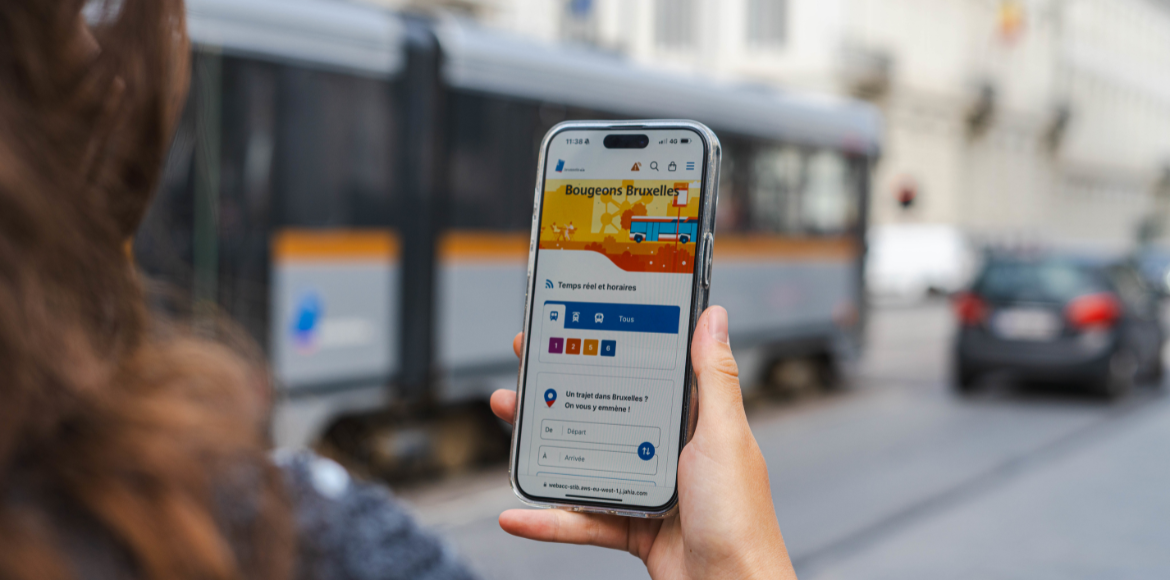A website designed with accessibility in mind: discover how the Brussels public transport operator met this challenge and draw inspiration from its journey towards inclusion.
At the beginning of this year, STIB reached a decisive milestone with the complete redesign of its website, becoming a model of accessibility and user experience. Beyond the need to comply with the World Content Accessibility Guidelines (WCAG). STIB is committed to offering a platform accessible to all – people with disabilities, regular users, and occasional users alike. This ambitious project offers valuable lessons for all organizations committed to implementing accessibility.
Through our discussions with Monika Bachul, Product Owner Digital Marketing at STIB, we gained insight into the new website where accessibility is truly seen as a driver for inclusion.
The challenges of a key player in public transport
Guarantee inclusive mobility
For the Brussels public transport operator, ensuring accessibility is a major challenge, particularly given the diversity of user profiles. With millions of daily journeys, a multitude of needs must be taken into account: people with disabilities or those with reduced mobility, parents, the elderly, regular travellers or tourists, etc. Everyone has specific expectations, possibly due to physical, sensory or cognitive constraints.
Everyone should be able to plan their trip, purchase a ticket, navigate and travel independently, and receive useful information, all while ensuring independence and non-discrimination. This challenge is all the more crucial in a capital city where transportation plays a major societal role.
The design of the new STIB website contributes to the challenge by ensuring clear, simple and inclusive communication to enable everyone to surf independently and smoothly, thus strengthening accessibility and equity in public spaces.
Better than a constraint, accessibility becomes added value
As a public company, STIB is required to comply with the Brussels ordinance on digital accessibility, by complying with WCAG 2.2 AA level. These guidelines ensure that digital platforms are usable by all people, including those with disabilities.
But for STIB, it's not just about complying with standards. Accessibility has become an added value because it requires a close focus on user experience.
Combining infrastructure and digitalization
Accessibility is a two-pronged challenge for STIB. On the one hand, with a vast network of buses, trams, and metros, STIB is investing in improving the physical accessibility of its facilities (adapted vehicle fleets, accessible stops, adapted signage, voice announcements, etc.) to ensure better mobility for all. On the other hand, digital accessibility provides users with access to essential services, such as purchasing transport tickets, planning journeys, consulting timetables or searching for practical information in real time.
But this digital accessibility faces certain challenges, particularly in terms of design and consistency with infrastructure. For example, the colors of bus/metro/tram lines do not yet have the right contrasts on the site because they respect the network colors to ensure consistency for users. Digital accessibility can therefore have repercussions on infrastructure. Infrastructure accessibility data, for its part, must be organized to enable good digital integration.
Raise awareness about accessibility
With over 10,000 employees, many teams at STIB are impacted by accessibility issues. It is therefore essential to raise awareness and support teams in this process. This ongoing investment is essential to anchor a culture of inclusion and ensure everyone understands accessibility issues.

How did STIB prepare for accessibility?
To meet the challenges of digital accessibility and comply with WCAG AA standards, STIB has increased the skills of its teams and partners and established solid accessibility foundations from the outset.
Training in accessibility
The first key step was to train internal teams and partners. From project managers to designers and developers, everyone was involved. These training sessions helped raise awareness among teams, disseminate accessibility best practices, and foster a new approach to working.
Taking these courses allowed designers and developers to acquire specific technical skills to apply accessibility principles to the website. They learned to:
- Design interfaces that meet needs in terms of contrast, navigation and information hierarchy.
- Develop features that are compatible with assistive technologies, such as screen readers or keyboard navigation.
The result? A team trained in accessibility and an AnySurfer certification for Jérémy, a front-end developer at Smile specializing in web accessibility. Having a skilled team that understands accessibility and integrates it from the start has allowed for continuous corrections to designs and developments, saving time, and meeting quality requirements.
Have an “Accessibility by design” approach
Since we wouldn't build a house without foundations, the goal was to no longer consider accessibility as a constraint or a final step, but as a pillar to be integrated into projects from the start.
Developing a digital charter from the outset was also a key element of accessibility. This charter was designed as a practical guide to ensure that all aspects of the site adhere to accessibility principles from the outset. It includes concrete recommendations on:
- Design (contrasts, font sizes, content alignment).
- User interactions (easily clickable buttons, simplified navigation).
- Content (use of alternative texts for images, clear and inclusive writing).
Surround yourself with experts
While STIB and CAWaB have been working together for over 10 years to better address the needs of people with disabilities, digital accessibility has led to a new collaboration.
From the outset, STIB surrounded itself with experts and stakeholders specializing in digital accessibility, such as AnySurfer. This support helped strengthen its inclusive approach by setting up focus groups, ensure more effective compliance through ongoing support, and ultimately, design a certified platform that is truly accessible to all.

The pillars of accessibility for the STIB website
From the very beginning, an “Accessibility by design” approach was adopted, allowing accessibility to be integrated into every stage of the design.
The design system perfectly illustrates this philosophy. Accessibility has been an integral part of it from the very beginning. Each component has been designed to be modular and compliant with accessibility standards, providing long-term consistency and ease of use. The design system documentation includes accessibility principles, and the design system itself has undergone a thorough audit by AnySurfer, achieving excellent results!
From the design phase, the designers created screen prototypes accessible to ensure clear and intuitive navigation, by applying WCAG 2.2 (adapted contrasts, optimized line spacing, clear spaces, double validation, adapted content, etc.).
Accessibility was incorporated into the code development to ensure that visual content is understandable and usable by people with disabilities. This includes the use of technologies like ARIA (Accessible Rich Internet Applications), which improve communication between interfaces and screen readers. With ARIA, essential information is added to describe interactive elements (such as buttons, drop-down menus, or forms), so that users using assistive technologies can enjoy a smooth and comprehensive experience.
Additionally, emphasis was placed on microinteractions, ensuring that they are not only intuitive for users without disabilities, but also rich in information for screen readers. For example, alerts, status changes, or visual notifications are accompanied by voice announcements or text descriptions, allowing all users to clearly understand what is happening in the interface.
User testing also played a key role in ensuring the site's accessibility, with a broad, representative sample, including people with disabilities. This feedback helped refine every detail of the design to meet everyone's needs. The digital charter was also tested through these tests.
After user testing and development sprints, Wassime, a tester at STIB and an expert in real-life situations, as he is visually impaired himself, evaluated the site under real-life visual accessibility conditions. His feedback helped validate or identify areas for improvement. His involvement was a real asset, facilitating discussions with the teams and strengthening the site's inclusivity before AnySurfer's final validation.
At the end of each sprint, AnySurfer rigorously tested each new feature, allowing for quick identification and adjustment of areas for improvement, as well as ensuring that each screen, interface, or feature was optimized for maximum accessibility. AnySurfer had access to wireframes in Figma and the Design System, which facilitated collaboration.
A commitment from the start and for the long term
STIB's new website perfectly illustrates the importance of integrating digital accessibility from the design stage to ensure a seamless and inclusive experience for all users. By going beyond legal requirements, STIB is establishing itself as a mobility player committed to accessibility, combining technical requirements with intuitive design.
But accessibility remains a daily challenge in order to maintain best practices and quality. The goal of renewing the AnySurfer label every two years requires constant vigilance. For example, conducting regular monitoring to verify the site's content and ensure it is " FALC " (Easy to Read and Understand). This aspect of accessibility is relatively new. It is crucial to ensure that the texts are understood by as many users as possible and contributes to fulfilling an essential mission for a public transport operator such as STIB.
At Smile , we believe that accessibility is no longer a constraint, but a powerful lever for improving the user experience and strengthening the impact of digital technology. Designing accessible platforms means, above all, adopting an inclusive approach, where every user, regardless of their abilities, can interact intuitively and effectively. This project demonstrates that performance, ergonomics, and accessibility go hand in hand, and that inclusion should be a standard, not an option. By supporting our clients in this process, we are helping to shape an inclusive and more efficient digital world for all.
Get ready for accessibility
Talk to our experts to build an accessible experience for everyone. Get in touch with us.


